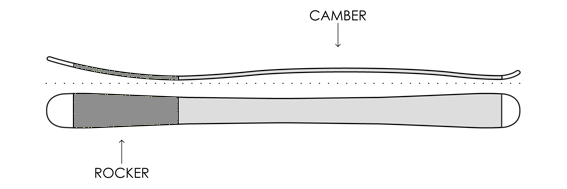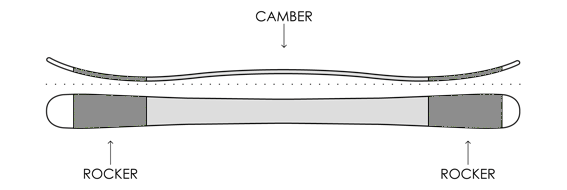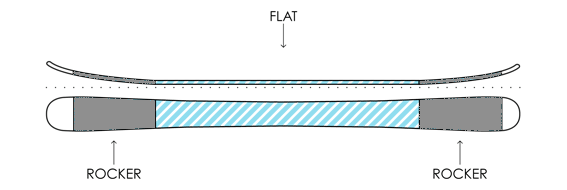Choice of skis
HOW TO CHOOSE THE RIGHT SKIS
When selecting the ideal skis for your skiing profile, there are four key elements to consider:
- Capacity level
- Skid width and curve radius
- Type of rocker
- Ski programme
 CAPACITY LEVEL
CAPACITY LEVEL
Today, different technologies allow beginners to use all types of skis, including wider skis. However, there are still features that differentiate skis depending on your ability level.
BEGINNER/INTERMEDIATE
A skier who is just starting to ski or who is working on making smoother turns falls into this level of ability.
Choosing skis
- Flexible and gentle
- Narrow skate width
- Composite foam or wood core
- Double Rocker (heel + tip)
The idea is to create a ski that is easy and tolerant of mistakes.
The addition of rocker makes the skis less grippy and gives you the sense of support in the turns.
INTERMEDIATE/ADVANCED
The majority of skiers and skis fall into this level. These skis are generally a little wider than intermediate or beginner skis, with a stronger wood core and sandwich construction. Depending on the type of ski, intermediate skis may have camber and rocker or a combination of both.
ADVANCED/EXPERT
More aggressive and skilled skier.
You will often find layers of Titanal, carbon, linen or other materials designed to offer better performance in fast or demanding conditions. Expert/advanced skis are generally stiffer in both length and torsion than intermediate skis and can be difficult to ski at slow speeds. You will find level, park, mountain and expert level powder sculptures with a wide variety of rocker configurations.
SKI STYLE AND FEEL
There are many factors that contribute to your skiing pleasure.
The main ones are: skate width, curve radius and rocker type
These three elements play an important role in the compatibility of a ski with its skier:
SKATE WIDTH
This is the width of the middle of a ski (skate), which is usually the narrowest point. Narrower skate widths are faster in turns, while wider skate widths offer better flotation in powder and shaken snow.
You will usually see the ski dimensions specified by a 3-number measurement called the rib line, for the tip or nose/ waist or runner/ tail or heel (e.g.: 115/90/107mm). In this example, 115 mm refers to the width of the spatula, 90 mm refers to the width of the skate, and 107 mm refers to the width of the heel.
CURVE RADIUS
The curve radius or sidecut (expressed in metres) is the shape of a ski determined by the rib lines (tip/pad/heel). The narrower a ski size is in relation to its tip and tail, the shorter and therefore deeper the radius of the curve. A ski with a deep (short) sidecut will make faster turns, while a ski with a subtle (long) sidecut will turn more slowly and is generally more stable at higher speeds.
Some modern skis combine two or more lines on one edge.
Curve radius |
Type of turn |
Type of ski and skier capacity |
|
<16m |
Short |
Ski carving and mountain/powder skiing with conical tips and rods |
|
17-22m |
Medium |
All-Mountain, park and pipe skiing |
|
> 22 m |
Long |
Powder & Big-Mountain |
 TYPE OF ROCKER
TYPE OF ROCKER
The camber is the longitudinal shape that is given to the ski. Areas that are elevated above the snow are called Rocker.
TRADITIONAL CAMBER
When a traditional ski is placed on the ground, the contact points of the ski on the snow are located near the tip and tail, while the centre of the ski (under the bindings) lifts slightly.
This construction offers excellent precision with a lot of energy on groomed terrain and harder snow. High-level park skiers often prefer this camber.

100% ROCKER/TIPPER
The Rocker is a reverse camber. This type of rocker offers superior flotation in soft powder snow. On a ski with reverse camber or "rocker", the tip (but also the tail, depending on the shape) lifts off the ground much earlier than on a cambered ski, which moves the contact points towards the centre of the ski.
Rocker skis are easier to turn between turns and can be skied for slightly f longer than camber skis.

ROCKER IN SPATULA OR HEEL
A rocker in the tip of the ski will allow the ski to be lifted more easily in fresh snow and thus provide better flotation, while a rocker at the back of the ski allows better manoeuvrability in powder.
Scalable piste skis: a slight front rocker + a classic camber
All-mountain skis: 30% rocker + 70% classic camber

ROCKER/CAMBER/ROCKER
The Rocker/Camber/Rocker skis have the enjoyment and float of a rocker ski and the support of a cambered ski. The contact points on the skis with this profile are closer to the middle of the ski than a fully cambered ski. The cambered midsection provides a longer effective edge on the hardpack, increasing stability and edge hold, while the tipped tip and tail provide flotation in deeper snow. This profile offers an escape for park skiers, flotation for powder lovers, tolerance for beginners and versatility for those who only have one pair of skis.
Many ski manufacturers offer several types of "Rocker/Camber/Rocker" to accommodate different skiers, combining different amounts of rocker and camber with different ski widths and sidecuts.
Versatile freeride skis: 50% rocker + 50% classic camber

ROCKER/FLAT/ROCKER
The latter will have better behaviour in powder, but will sacrifice its ability to grip on hard snow since the contact surface with the snow is minimal. The ski pivots very easily around the skate for greater manoeuvrability, but this still takes some getting used to. The performance is between a fully balanced ski and a rocker/camber/rocker ski.

No one profile beats the other that matches your personal preferences.
As a general rule, the camber offers better handling and stability on the park and at high speeds, while the rocker offers more flotation in powder snow and a more forgiving ride. Advanced skiers who like strong sensations can also enjoy using rocker skis.
THE IMPORTANCE OF A ROCKER
A rocker offers increased flotation in powder snow!
The feeling is smooth and just like surfing, wakeboarding or waterskiing, the rocker helps you float and stay above the snow. On skis or on a board, your tip extends so you can avoid sticking it in the snow. On the skis, bouncing and cushioning are effortless. You can maintain a more balanced driving position that saves energy and improves your reaction time.
Easier to manoeuvre
The rocker lifts the heel and tip up and off the snow, shortening the contact length of the edges and making turns easier. Your walk becomes easier and more manageable, allowing you to pivot and "glide" easily. The increased mobility is ideal between trees and narrow paths.
Facilitates the practice of the park
The less attractive nature of a ski or snow rocker allows you to initiate your spins early and gives you a greater ability to recover from off-axis landings.
FOR WHOM?
Everyone can choose a ski or snowboard with a rocker and have fun. Beginner to expert, young or old, take advantage of rocker technology. Easier and more fun. Today, manufacturers such as Rossignol, K2, Burton and many others have developed multiple combinations so that you can find the one that suits you.
FOR WHAT?
You can practice all terrains and programmes, freeride, freestyle, powder, park and off-piste circuit, the rocker is not an obstacle.
However, avoid glaciers and rough off-piste terrain. These require very specific skis adapted to this practice.
SPECIAL WOMEN'S SKIS
All adult skis can be skied by both men and women. In addition, many women's skis today have a rigid construction.
However, women generally have a lower centre of gravity and less body mass than men of the same height and therefore exert less weight and force on their skis. Therefore, women's skis are lighter, smoother and shorter and require less force to turn.
These skis are built with a thinner, softer core and fewer laminates. The mounting positions of the fasteners are more forward.
FAVOURITE PROGRAMME
You will find many programmes,
Performance, carving, piste, leisure, all mountain, freestyle, freeride, backcountry, park, touring, free touring, light touring, splitboard.
You will also see that ski ranges are becoming more versatile so that one ski can be adapted to several programmes to allow skiers to practice more widely with one or two pairs of skis maximum.
No more need to overspend!!!
PERFORMANCE
A range of skis dedicated to thrill-seekers on the pistes who have mastered the carve and are looking for a ski that is high-performance yet versatile and comfortable. Versatility here refers to the ski's ability to control itself in short, medium and long turns, but also to its ability to go from carve to glide. On these skis, the skier looks for maximum control and acceleration, in order to find a sporty feeling on the piste. These skis are of excellent construction and very high quality.
SKID WIDTH: from 62 mm up
CARVING
A beautiful, well-groomed piste is your ultimate pleasure. You master (or are trying to master) carving go full-out on it. You don't deny yourself a little straight run, arrow or a chamois to test yourself, but speed is not an end in itself. Likewise, you ski everywhere, even if your goal is to carve crazy curves, with style and speed.
PISTE
These skis are often derived from "piste performance" skis and are designed to be progressive and reassure the aspiring skier. Obviously, the first consideration is price before skiability. "Piste" skis must allow you to skid without getting stuck, help you enter the curve by assisting the first phase of the turn, in short, they must be easy and reassuring, which does not prevent a some performance.
LEISURE
Seen on the slope, these skis are the ones that suit the most people, whatever the terrain or the level of the skier. Good anywhere, they are somewhat less effective in terms of performance and stability or the capacity to ski in slightly deeper snow. This versatility necessarily becomes a weakness if we look at the criteria one by one ... Most often accessible and facilitating, these skis are perfectly suited to skiers who are not looking for too much of a fight or who want a nice and efficient ski, but not too demanding or sharp.
SKID WIDTH: between 75 and 85 mm
ALL-MOUNTAIN
As the name suggests, these are for skiing anywhere on the mountain. All mountain = versatile. All-mountain skis are designed to tackle all terrain, including powder, ice, groomers, steeps, heavy snow and everything in between, but they are not necessarily the ultimate in any of these. If you are not looking to experiment with a specific programme, you can go for a pair of all-mountain skis.
All-purpose skis generally have a so-called "mid-fat" width of 80 to 100 mm.
The key is to know where you will spend most of your time in the mountains and what type of terrain you like to ski the most.
You will also choose this type of ski according to what you want to tackle.
FREESTYLE
Freestyle skis are all double-tipped so that you can ski forward and backward (switch). However, they are not all the same. We distinguish between two main categories: hardcore freestyle and accessible freestyle. The former are designed to hit big kickers and are not necessarily easy to ski, whereas the latter allow you to learn freestyle, but are above all very versatile skis, skis that can be used for anything..
SKATE WIDTH: Between 85 and 95 mm
FREERIDE
All you can think about is checking the spot. For you, skiing is on the other side, where the slope is immaculate with virgin snow. And if you are never reluctant to ski on piste, the combes, the forest, the open slopes and the narrow corridors are your favourite hunting grounds. For the rest, powder is your drug, your knowledge of the environment and the snow your guardian angel.
BACKCOUNTRY
Backcountry or Big Mountain Rocker skis are first and foremost image skis, skis with generous and non-standard measurements, made for the great outdoors and to go off-piste. Unlike a few years ago, these skis are still generally skiable on the pistes and have made some interesting compromises that make them less exclusive than before. Of course, the products are specialised but often easy to use, playing on the pivot and their lift to facilitate skiing in powder while offering a different way of approaching these terrains. These are fun skis, with double tips, but not very demanding.
SKID WIDTH: between 105 and 130 mm
PARK/PIPE
Park/pipe skis, often referred to as freestyle skis, are for skiers who spend most of their time in the terrain park. If jumps, rails and beams of any kind are your passion, this is the category for you. Although traditionally park/pipe skis have narrower edges with full construction, this category incorporates more rocker models and different shapes. You will almost always find these skis with double tips and other park-specific features, with thicker and stiffer edges.
TOURING
Touring skis have recently converted to rockers, which makes them more modern and easier to handle off-piste. Light to very light, these skis have a width of between 80 and 90 mm at the skate to keep them as weightless as possible.
SKID WIDTH: between 80 and 90 mm
FREE/LIGHT TOURING
It's the new Eldorado for ski manufacturers! More than a range, it is a practice that combines off-piste and touring, all of which can now be done thanks to the enormous progress made by manufacturers, particularly in bindings and boots. In the past, touring meant sacrificing the pleasure of going downhill, while off-piste skiing made it impossible to go back up on your own, as the equipment was so heavy and unsuitable.
The logic of this range revolves around a 95 mm lightweight ski with a light binding.
SKID WIDTH: around 95 mm (but up to 125 mm!)
SPLITBOARD
The splitboard is made specifically for snowboarding.
Snowboard touring is here!, A light and manageable snowboard that you split into two parts for touring and put together into a traditional board for freestyle/freeride.
You can now combine snowboarding and touring with a single snowboard to reach the roughest terrain.
SEE OUR BEGINNER LEVEL SKIS SEE OUR INTERMEDIATE LEVEL SKIS SEE OUR ADVANCED LEVEL SKIS SEE OUR EXPERT LEVEL SKIS
